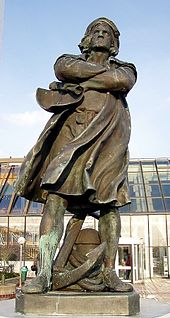Ludwig Habich

Ludwig Habich (born April 2, 1872 in Darmstadt , † January 20, 1949 in Jugenheim ) was a German sculptor , medalist and university lecturer .
life and work
At the age of six, Ludwig Habich joined the sculptor Benedikt König (1842–1906) as a pupil in 1879 , with whom he studied until 1886. From 1890 he studied with Gustav Kaupert at the Städelsche Kunstinstitut in Frankfurt am Main , then with Hermann Volz at the Karlsruhe Art Academy and with Wilhelm von Rümann at the Munich Art Academy . Although he did not finish these studies until 1900, apart from his studies he carried out his first independent works as early as 1893.
Habich achieved his first major success outside of his Hessian homeland in 1897 with the Columbus monument for Bremerhaven , which was awarded at an art exhibition in Munich. In 1898 he was a founding member of the Free Association of Darmstadt Artists . In 1899 he was appointed by Grand Duke Ernst Ludwig as a member of the Darmstadt artists' colony . Habich created for Darmstadt the colossal figures of man and woman at the entrance to the Ernst Ludwig House on Mathildenhöhe , a fountain with a larger than life relief figure of a drinking youth at the Olbrich House and the Goethe monument in Herrngarten . Two other works by Ludwig Habich can be seen in the old district court building in Darmstadt. In the entrance hall, on the side of the halls of the criminal courts, there is a lightning bolt with a plaque of law as the embodiment of punitive justice, and on the side of the civil courts, a girl who veils herself can be seen as a symbol of public shyness.
Goethe monument in the Herrngarten in Darmstadt
Princess Elisabeth's tomb on the Rosenhöhe in Darmstadt
In 1906 Habich moved to Stuttgart , where he initially taught sculpture and three-dimensional design at the architecture department of the Technical University of Stuttgart . In 1910 he was appointed to succeed Adolf von Donndorf as a professor at the Stuttgart Art Academy , where he remained until his retirement in 1937. Ludwig Habich's students were Frida Christaller , Emil Hipp , Lilli Kerzinger-Werth (master student ), Fritz Nuss and Franziska Sarwey. His best-known works in Stuttgart include the sculpture of a convalescent from 1911 for the Hermann Burckhardt monument on Hegelplatz and the figure of a golden stag as the crowning of the dome of the art building from 1913.
Habich's main artistic motif was the moving figure of a young man, which he often varied. With this motif and his relatively traditional artistic style, he also corresponded to the National Socialist conception of art. During this time, a young man's figure, created as early as 1900, was particularly valued; it originally bore the title "Towards the Stars", but was then reinterpreted as " The German Greeting " because of the posture it depicted and was awarded a culture prize in 1940.
After his house in Darmstadt was destroyed in World War II, he moved to Jugenheim an der Bergstrasse in 1945. He died there in January 1949. Ludwig Habich was buried in the old cemetery in Darmstadt (grave site: ID 121a). His estate is kept in the Darmstadt city archive. His work catalog comprises 504 items, including 23 monuments, 32 tombs and 189 statues, architectural sculptures and busts. He designed numerous medals and official coins for the German Empire, the Grand Duchy of Luxembourg and the Kingdom of Poland.
literature
- Arthur Dobsky: Ludwig Habich. In: Illustrirte Zeitung (Leipzig). 151, 1918, No. 3932, p. 523 f.
- Roecker, Hanns Otto: The sculptor Ludwig Habich . In: Württemberg. Monthly in the service of people and homeland, 1932, pp. 341–346.
- Erich Heyfelder: Ludwig Habich and his sculpture school at the Stuttgart Art Academy. In: Schwäbisches Heimatbuch , 1935, pp. 53–66.
- Edith Neumann: Artists in Württemberg. On the history of the Württemberg Association of Women Painters and the Federation of Women Artists of Württemberg Volume 1. Stuttgart 1999.
- Dorothea Stern : Habich, Ludwig . In: Ulrich Thieme , Fred. C. Willis (Ed.): General lexicon of visual artists from antiquity to the present . Founded by Ulrich Thieme and Felix Becker . tape 15 : Gresse – Hanselmann . EA Seemann, Leipzig 1922, p. 401-402 ( Text Archive - Internet Archive ).
- Peter Weyrauch : The sculptor Ludwig Habich (1872–1949). Hessian Historical Commission, Darmstadt 1990, ISBN 3-88443-166-8 .
- Ludwig Habich. In: Historischer Verein für Hessen (Hrsg.): Stadtlexikon Darmstadt. Konrad Theiss Verlag, Stuttgart 2006, p. 339.
Web links
- Short biography of Ludwig Habich on the website of the German Peace Society - United War Resisters, Darmstadt Group , accessed on November 16, 2012.
Individual evidence
- ^ Peter Weyrauch: The sculptor Ludwig Habich (1872-1949). Hessische Historische Kommission, Darmstadt 1990, p. 11 and p. 13. ( online as a snippet view at Google books )
- ↑ Wolfgang Kermer : Data and images on the history of the State Academy of Fine Arts Stuttgart . Stuttgart: Edition Cantz, 1988 (= improved special print from: The State Academy of Fine Arts Stuttgart: a self-portrayal . Stuttgart: Edition Cantz, 1988), o. P. [p. 9]
- ↑ #Neumann 1999.1 , p. 128. - Detailed list of students: #Heyfelder 1935 , p. 63.
| personal data | |
|---|---|
| SURNAME | Habich, Ludwig |
| BRIEF DESCRIPTION | German sculptor and medalist |
| DATE OF BIRTH | April 2, 1872 |
| PLACE OF BIRTH | Darmstadt |
| DATE OF DEATH | January 20, 1949 |
| Place of death | Youth home |





